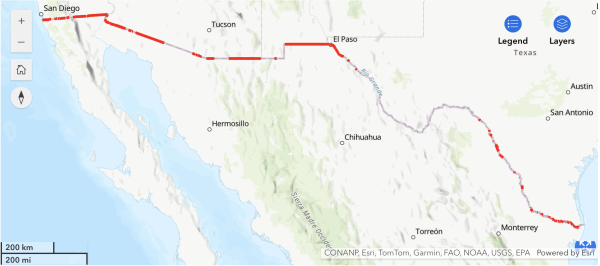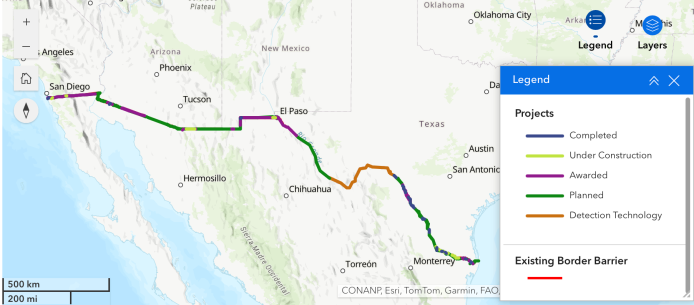President Donald Trump is swiftly moving forward with a keystone campaign promise from his first term: to build the border wall.
Within six months of returning to the White House, Trump has been able to acquire nearly $5 billion in congressional funding to finish the border wall he first set out to construct in 2017 but did not complete before leaving office in 2021.
Unlike in his first term, the second Trump administration has a significant head start on building and should have no problem finishing the project by 2029.
But there is one technical difference: This time around, the project is called a “smart wall.” Although technology was utilized in the border barrier system during Trump’s first term, it plays an even larger role in safeguarding the country now.
In fact, every one of the 1,954 miles of the border with Mexico will have a “smart wall,” allowing the White House to carry out what it first set out to accomplish nearly a decade ago.
“The Smart Wall means more miles of barriers, more technology, and more capability for our agents on the ground. This is how you take control of the border,” U.S. Customs and Border Protection Commissioner Rodney Scott said in a statement.
The quest to build a wall
Border wall construction is nothing new. Projects took off in the 1990s, when then-President Bill Clinton approved a Border Patrol hiring surge and infrastructure. A decade later, during the George W. Bush administration, Congress approved the Secure Fence Act, which funded more than 650 miles of barrier.
Half of those 650 miles of barrier had short fences just tall enough to block vehicles from driving across rural parts of the border, while the other half was tall enough to prevent people from illegally walking over. Border wall projects continued, albeit at far slower rates, during the Obama administration.
The first Trump administration did not install a mile of wall in a previously unfenced part of the border in its first 30 months in office and instead focused on projects replacing dilapidated fencing. The delays in getting started were due to several factors, including poor planning, problems acquiring private and public land, and funding shortages.
Trump completed 450 miles of the 740 that were funded before leaving office. When former President Joe Biden took office, he froze and later canceled the remaining wall projects.

The One Big Beautiful Bill delivers
The last time there was a government shutdown was in early 2019, when the Trump administration fought with Congress for $18 billion in border wall funding.
This time around, Republicans tucked $46.5 billion for the project into the One Big Beautiful Bill, which Congress passed in late spring and Trump signed on July 4.
Over 1,400 miles of the entire southern border will have a physical barrier to deter people from crossing by the time the current and future projects are completed.
The remaining 535 miles are not viewed by planners as ideal for building a wall or are considered low-risk areas for illegal crossings. However, the 535 miles will be provided with detection technology.
In addition, CBP is installing 550 miles of technology in parts of the border that have a physical barrier but lack sensors in the ground, cameras, and other technology.
Defining ‘smart wall’
In early October, the Department of Homeland Security and CBP announced 10 new construction projects as part of the smart wall, funded by $4.5 billion of the $46.5 billion for border security in the One Big Beautiful Bill. A small portion of the projects was funded by unused money that Congress appropriated for the border wall in fiscal 2021.
CBP is the federal agency handling the planning of the smart wall. The agency said the objective of a smart wall is to combine two parallel steel walls with waterborne barriers, patrol roads, and technology in an effort to give Border Patrol agents “operational control” of the border.
CBP defines a smart wall as a border wall system that includes a steel bollard wall or waterborne barrier, roads, detection technology, cameras, and lighting, as well as a secondary wall in some cases.
In select unspecified areas of the border, the physical barrier will be painted black as part of the smart wall design, meant to heat up more than the reddish brown portion.
To start, the Trump administration will install 230 miles of smart wall, complete with all elements. An additional 400 miles of the border will receive new technology.

Chuck DeVore, chief national initiatives officer for the conservative Texas Public Policy Foundation, said the smart wall will give agents “domain awareness.”
“Domain means not only are you aware of what is going on in the visual light spectrum, but what can you see in thermal? What can you sense in terms of radio frequency waves?” DeVore said in a phone call on Friday. “Seismic vibrations that are created when you build a tunnel. And radar.”
QUARTER-MILLION AMERICANS HAVE APPLIED TO BORDER PATROL AND ICE UNDER TRUMP
While a physical barrier can slow down those who cross illegally, technology and the addition of artificial intelligence and machine learning can take the images and information from sensors and cameras and reach conclusions faster than humans.
“When you have domain awareness with the fusion of critical intelligence, then you have a machine gathering all of this stuff in relation to time and presenting a picture to you that is a real-time understanding of what is going on at the border,” DeVore said. “That allows you to deploy your limited assets … so now you can move to meet the threat.”
